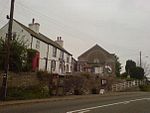Old Church of St Gwenllwyfo, Llanwenllwyfo

The Old Church of St Gwenllwyfo, Llanwenllwyfo is a medieval ruined church near Dulas, in Anglesey, Wales, perhaps built in the 15th century to replace another church from which only the 12th-century font survived. Dedicated to Gwenllwyfo, a 7th-century female saint about whom nothing else is known, it was used as a chapel of ease for the church in Amlwch, about 5 miles (8 km) away. Restored in 1610 and again in the 18th and 19th centuries, it contained an oak screen and pulpit from 1610. It was replaced in the middle of the 19th century by a larger church about two-thirds of a mile (1.1 km) away, to which some of the contents, including a memorial brass plaque from the early 17th century and the church bell, were removed; other items were left behind. The disused church was noted to be in bad condition in 1937, and the roof collapsed in 1950. Little of the structure now remains, as the walls have been reduced to 5 feet (1.5 m) in height.
Excerpt from the Wikipedia article Old Church of St Gwenllwyfo, Llanwenllwyfo (License: CC BY-SA 3.0, Authors, Images).Old Church of St Gwenllwyfo, Llanwenllwyfo
Lon Storws,
Geographical coordinates (GPS) Address External links Nearby Places Show on map
Geographical coordinates (GPS)
| Latitude | Longitude |
|---|---|
| N 53.385787 ° | E -4.278499 ° |
Address
Old Llanwenllwyfo Church
Lon Storws
LL70 9LZ
Wales, United Kingdom
Open on Google Maps









